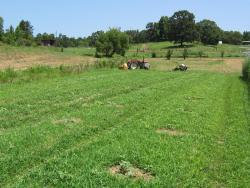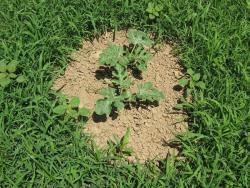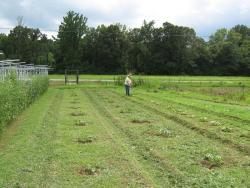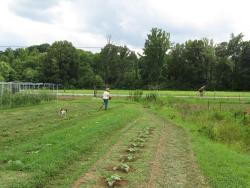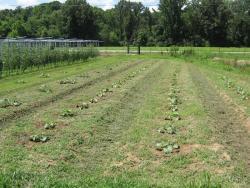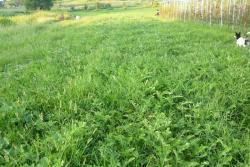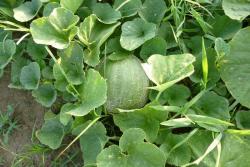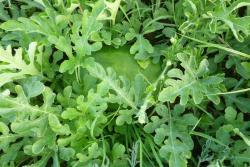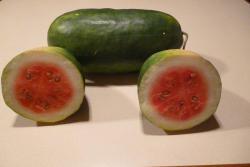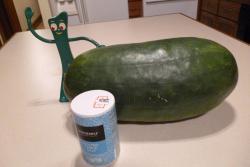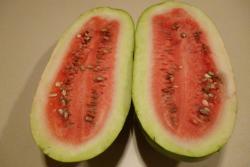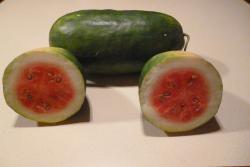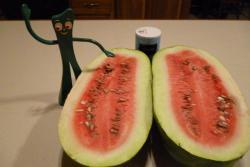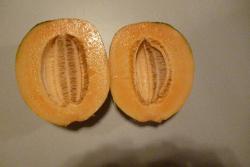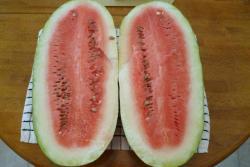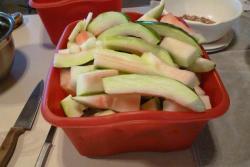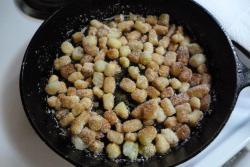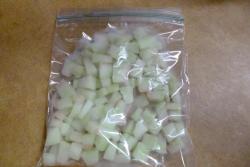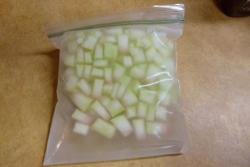I have hesitated and put off creating this thread for a while because I didn't want to start something I couldn't finish.
This project may still end in disaster, but it's far enough along some others may benefit from it, so here goes.
From the other Schochler thread several people had planned to grow this watermelon, but I haven't seen anyone post their results yet. I do things a little different (not necessarily better) than most folks. I'll try to explain the reason behind the madness as we go along.
I don't use any insecticides, herbicides, commercial fertilizers, or animal manures. I made an exception for the watermelons and cantaloupes this year and did use 1/2 cup of aged chicken manure (5 years old) per hill. It probably wasn't necessary as the runners grew a foot per day and a little slower growth might have been better.
Boy what a year so far. Rain, rain and more rain. My garden has flooded 8 times so far this year. I grow on 4' x 100' earth bermed raised beds with 3' wide middles. When it floods the wide middles allow the waters to drain off before the plants on the raised beds are damaged. During a normal shower the grass on the beds and in the middles slow the runoff allowing more water to soak into the soil while acting as a live mulch, trap crop for insects and green manure for the vegetables.
I normally use a garlic, hot pepper, and sage tea to confuse and repel insects from my vegetables instead of insecticides. The logic is if the insects don't lay their eggs on your plants, you eliminate a lot of your insect problems. Insects are like people in that they will eat just about anything when they get hungry and insects are born hungry. Most of the insects in my garden come from the pasture which surrounds the garden on all sides. When they arrive they find the same grasses and weeds growing in the middles and on the beds that they were eating in the pasture. I spray the garlic, pepper and sage tea on my vegetables and not on the grass and weeds. This works for many insects.
When I have a problem insect the tea doesn't repel, I try to find something that particular insect doesn't like and make a tea from that plant to repel and confuse them. Sometimes it works, sometimes it doesn't.
Cucumber Beatles and Stink bugs are two insects I had not found a solution for. I had read about a beneficial bacillus which when the roots were inoculated with this bacillus would cause the plants to repel Cucumber Beatles. I found a source for the bacillus and tried it this year. It works. I haven't been able to find a single Cucumber Beatle or Stink bug on any of the watermelons or cantaloupes.
Because I was trying the bacillus I only used the garlic, pepper, sage tea at plant out (It masks the odor of seeds so raccoons don't dig them up.). Just anecdotal evidence I know, but it's anecdotal enough that I'll be using this from now on.
The plants haven't been spray with anything until 3 weeks ago when I started spraying with the garlic, pepper and sage tea to repel deer, raccoons, and crows.
The closest watermelons and cantaloupes are 2 miles away so the seed should be pure. A friend who has a CSA grew the ones which are 2 miles from my garden and the deer and raccoons ate every one of hers. She and her members didn't get a single melon or cantaloupe. That's why I started spraying with the tea. The morning after I sprayed I found 2 watermelon runners and 3 cantaloupe runners with the tip bit off along with one cantaloupe which had a bite taken out by deer (deer tracks). I guess I lucked out on that one.
The pictures below tell the story. The seeds were planted June 1st, 5 weeks after our last frost. Watermelons were planted on 7' rows with 8 feet between hills. 3 seeds per hill thinned to the strongest 2 plants after true leaves had formed. Germination was about 95%. Cantaloupes were planted on 7' rows with 3 feet between hills. 10 seeds per hill (old seeds; a germination trial showed about 20%) thinned to the strongest 2 plants after true leaves had formed. Germination was about 85% (I blame the difference on the bacillus inoculant as that was the only thing different from the trial.).
When the plants have their true leaves the hills are thinned to the strongest 2 plants and a hoe and hand are used to remove the grass for about a foot around each hill. The grass was allowed to grow for another 4 days, then a weed eater was used to trim the grass on the beds and in the middles. The clippings were allowed to dry in the sun for a day. A 24" gas tiller was used to till the grass and weeds into the soil on the beds. The grass in the middles was not tilled and was mowed as necessary. This allows the melons and cantaloupes to become dominant.
It's my understanding the reason melons like Schochler (dark skinned) fell out of favor here in the south is they tend to suffer from sunscald making many unmarketable. Hopefully allowing the grass to grow with them will prevent this.
If anyone is interested in the bacillus, I plan to start a separate thread on it. I would prefer to keep the discussion here about the Schochler and Israeli. Thanks, Claud.
